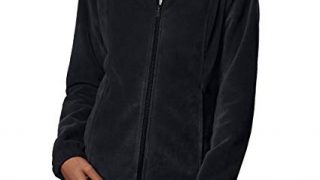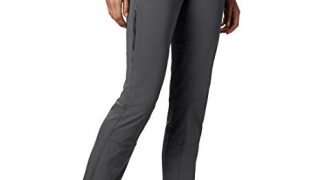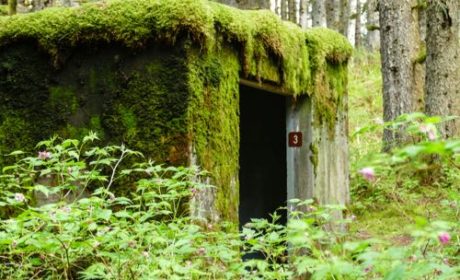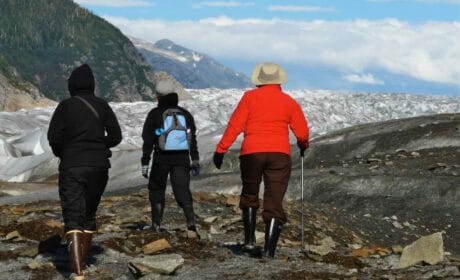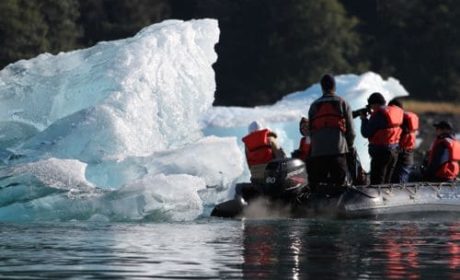Is Skagway cruise port on your Alaskan cruise itinerary? More than likely, it is.
There’s good reason for the Southeast Alaska town’s popularity. The combination of colorful Alaska history, Skagway’s walkable downtown and outdoor opportunities can’t be beat.
My Itchy Travel Feet featured writer, Debi Lander of ByLanderSea, recently visited. She writes about the best things to do in Skagway cruise port.
If you cruise Alaska’s wondrous Inside Passage (and you should, even if you’re not an avid cruiser), most likely, you will visit Skagway. Despite the ugly sounding name, the small town packs a colorful punch for tourists. In fact, the remote city thrives on tourism.
Skagway is home to a gold-rush-era story, preserved as part of the Klondike Gold Rush National Historical Park (website). Downtown Boardwalk Avenue features historic shops and restaurants, wooden sidewalks, locals in period costumes, and restored buildings and museums.
In addition, the White Pass & Yukon Railroad runs vintage locomotives that climb 3,000 ft. up 20 miles of steep grades before stopping at White Pass summit to admire the breathtaking mountain views.
Table of Contents
Skagway History
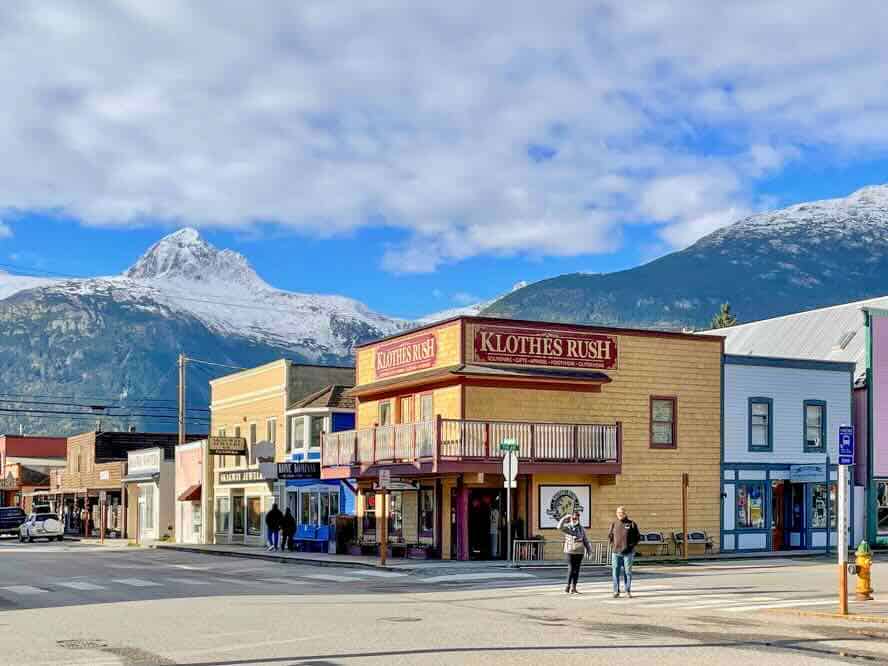
Before stepping back to the heyday of the gold rush days, let’s review the background and history of Skagway, Alaska. The Tlingit (tribe) resided in the area and created a trade route with the Athabascans.
A United States naval captain negotiated with the Tlingit to share the trail with gold stampeders. Tlingit guides accompanied the first party in May 1880 and transported the miners’ gear for a fee. This trip set the foundation for the Tlingit packing business, which thrived until the gold rush.
The town of Dyea arose from a small trading post to a major port in 1897 afterword of the Klondike gold discovery. Several trailside communities of tents and shacks soon developed along the trail.
Dyea sat closest to the Chilkoot Trail, a thousand-foot climb that some considered “the meanest 33 miles in history.” It remained the prevailing route to the Klondike until an April 1898 avalanche took 60 lives.
Skagway’s torturous White Pass lacked the steep slopes of the Chilkoot but was 10 miles longer and had its own obstacles. The trail was clogged with mud during the wet fall months of 1897, making it impassable at some spots.
As Tappan Adney, a journalist writing about 1897 in The Klondike Stampede, said, “Whichever trail you took, you wish you had taken the other.”
Adding to the trail’s difficulty was a mandate from Canada requiring each man to bring a year’s supply of food to prevent starvation. I can’t imagine gathering all the needed food and gear today, let alone in an isolated place.
The equipment weighed close to a ton, which most men carried themselves, moving it in back and forth stages. Their progression proved slow and led them over the steep pass in the bitter cold. Those who persisted and reached Lake Bennet on the other side then sailed 500 miles down to the Klondike River to Dawson City.
According to the National Park Service:
“Because the Chilkoot Trail was so challenging, most stayed in Skagway and pitched tents. While the town’s overcrowding increased, so did the prosperity of local businesses.”
Skagway became infamous for its lawlessness. More than 70 saloons thrived, giving the city the nickname “roughest place in the world.” The main rabble-rouser was Jefferson Randolph “Soapy” Smith. He masterminded a nine-month reign of gambling, prostitution, thievery, and murder.
White Pass & Yukon Railroad
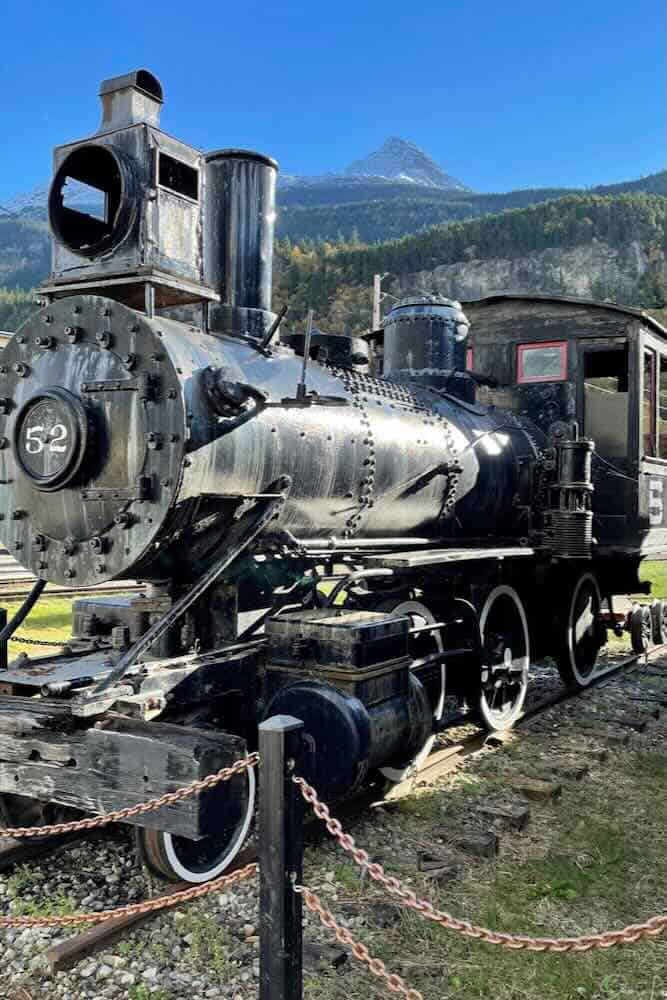
In 1898, construction began on the White Pass & Yukon Route Railroad and finished in July 1900. Some 35,000 workers labored to lay the 110 miles of track.
It is recognized as an International Historic Civil Engineering Landmark, awarded to engineering feats like the Panama Canal, the Eiffel Tower, and the Statue of Liberty. Sadly, the railroad was too late for the gold rush peak as many prospectors had already moved on. Dyea became a ghost town.
Gold mining production in the region peaked in 1903 after heavier equipment was brought in. Since then, the Klondike has been mined on and off.
Gold fever brought an estimated 100,000 prospectors to the isolated region with big dreams, but most of them failed. The population dropped down to just 872 in 1910.
Early Tourism
Another character in Skagway’s past is Martin Itjen, a stampeder in 1898 who became the unofficial director of tourism. Itjen held many jobs, including miner, railroad employee, hotel operator, the town’s undertaker, Ford motor car dealer, and a tour guide.
Soapy had been a friend, and Itjen helped keep his legend alive. He built a tour bus from an old Ford bus and referred to it as a streetcar, giving town tours.
In 1935, as a great publicity stunt, Martin took his “streetcar” to Hollywood to promote Skagway tourism. He called on Mae West to “come up and visit him sometime.” The newsmen and photographers loved it.
During WWII, the U.S. Army recognized the importance of Skagway’s location and took over the railroad. One soldier summed it up, “the work was too steep for a goat and too cold for a polar bear. “
After the war, Skagway residents again turned to tourism to help boost the town’s economy. They hoped the National Park Service would be interested.
Those connections weren’t granted until June 1962, when the city and the surrounding area became a National Historic Landmark. In 1976, after numerous studies, President Gerald Ford signed a bill authorizing the creation of the Klondike Gold Rush National Historical Park.
Boomer Travel Tip
Looking for things to do on your Alaska cruise? Check out our Alaska shore excursion reviews.
Skagway cruise port
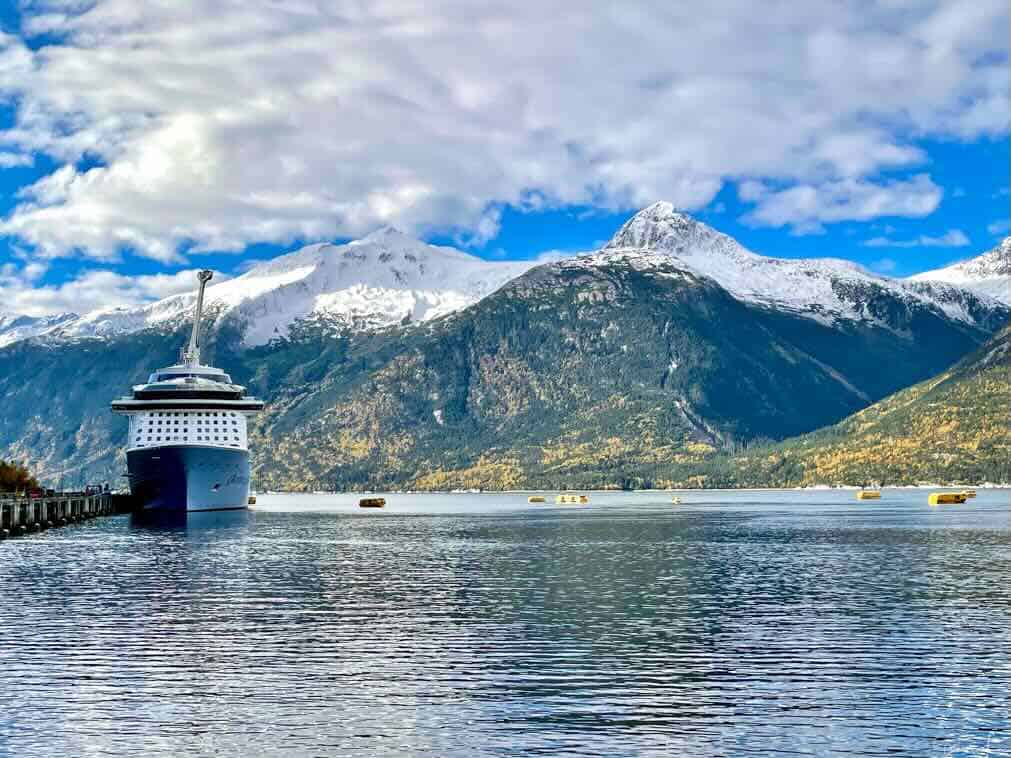
Skagway continues as a shipping and supply center but depends on tourism. The population (from 2019 records) hovers today around 800-1,000. I suspect it dropped even lower during the pandemic.
Every year, Skagway welcomes an astonishing million tourists. Most come in the summer on cruise ships with up to five boats per day.
More than 8,000 visitors (10 times the town’s resident population) make Skagway into a modern-day boomtown on the busiest days. Many take the National Park Ranger’s free, 45-minute tours, given up to five times a day.
A September cruise to Skagway
I arrived in the fall of 2021 on Royal Caribbean’s mega-ship, the Oasis of the Seas. I watched nature’s beauty as we sailed into Skagway’s majestic deep-water harbor surrounded by snow-capped mountains.
Autumn colors dotted the hillsides, and the little town looked inviting. On that September day, travelers on my boat were lucky; we were the only cruise ship in port.
I disembarked, choosing to make the long walk into town, although trams were available. My lengthy saunter on Congress Way took me past numerous signs that explained the town’s gold rush history.
Before long, I turned the corner and neared the first of the National Park buildings. The visitor center is housed in front of the 1898 railroad depot. As always, the park service offers learning opportunities through descriptive exhibits, a film, ranger presentations, or guided walking tours.
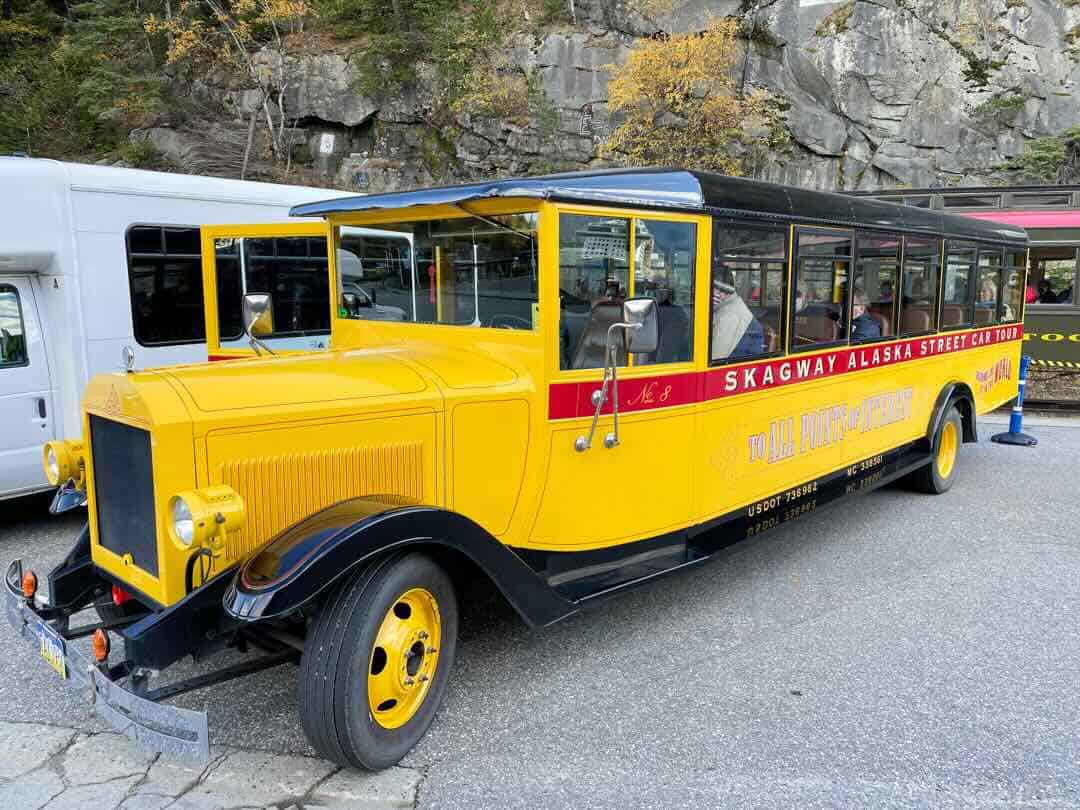
I signed up for an afternoon Street Car Tour; therefore, I just wanted to check out the lay of the land in the morning. I meandered along and found an old rail car and a railroad snowplow. Then, I headed to Broadway, the main street, where many businesses were just returning to pre-Covid activities.
Most stores offered enticing but higher-priced collectibles, not tacky souvenirs. Others from my ship roamed amongst the hand-woven baskets, fossils, walrus tusks, silver jewelry, and native arts. While I’m not big on shopping, these items interested me even if I wasn’t buying anything.
Of course, I also found purveyors selling food and snacks like the Klondike Doughboy, a large circle of fried bread coated in sugar.
The town streets feel like an old western movie set, but the mountain scenery shouts Alaska. I stopped for a photo-op at a Totem Pole, then slowly made my way back to the boat, snapping photos of the colorful buildings.
A S.M.A.R.T. shuttle bus leaves from the pier and follows a set schedule for anyone not up to a long walk. The buses stop at popular tourist spots in the town, so riders can hop on and off for just $5 a day.
Boomer Travel Tip
Need help packing for your Alaska cruise? Check out our Alaska Cruise Packing list!
Skagway excursions
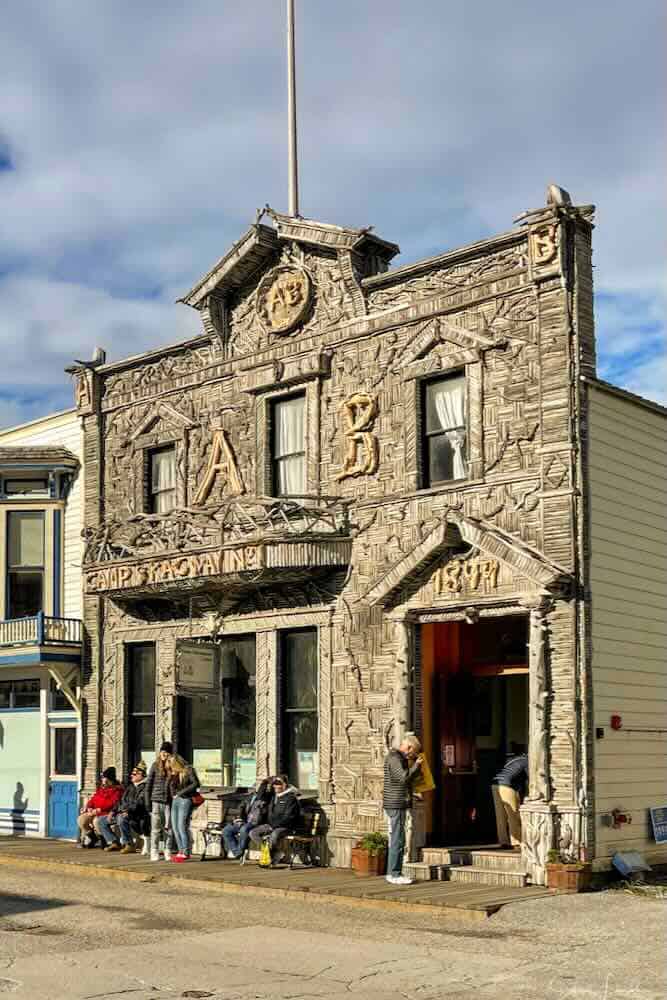
Cruise ships offer many pre-arranged excursions, but you can also hire a tour guide and outfitter on your own (book ahead with Viator). Make sure to confirm the time you must be back on the ship before taking off.
Pick from outdoor adventures such as helicopter flightseeing tours, a helicopter tour that includes landing on a glacier, or one that offers a dog-sled ride. You can hire a guide for hiking, wildlife viewing (you might see a bald eagle), or a photography tour. Take to the water on a sea kayak or perhaps a scenic float down the Taiya River.
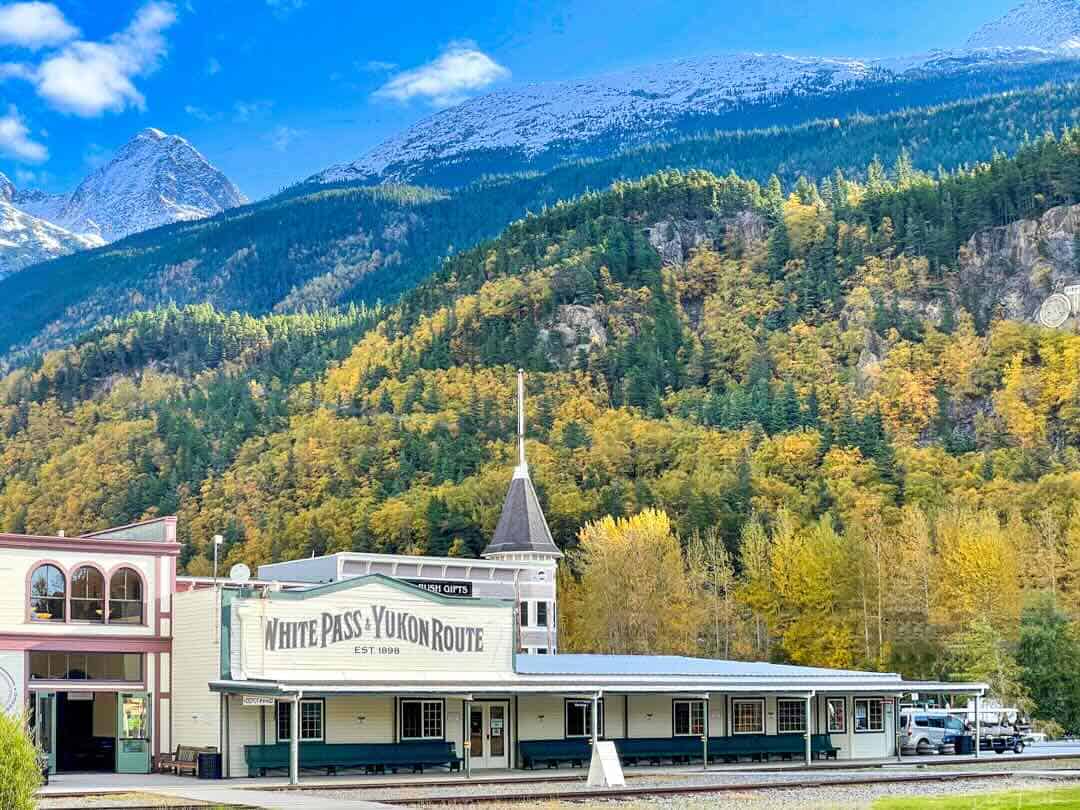
White Pass & Yukon Railroad The White Pass & Yukon Railroad, Originally built in 1898, offers the most popular tour (book independently). Passengers leave the depot aboard the historic narrow-gauge railway.
Excursions range from 2 hours to full-day, with options for hiking and camping drop-offs and connections to other Yukon destinations. White Pass sits at the top of the steep climb at 2,888 feet, also the international boundary between the United States and Canada.
Explore Klondike Gold Rush National Historical Park
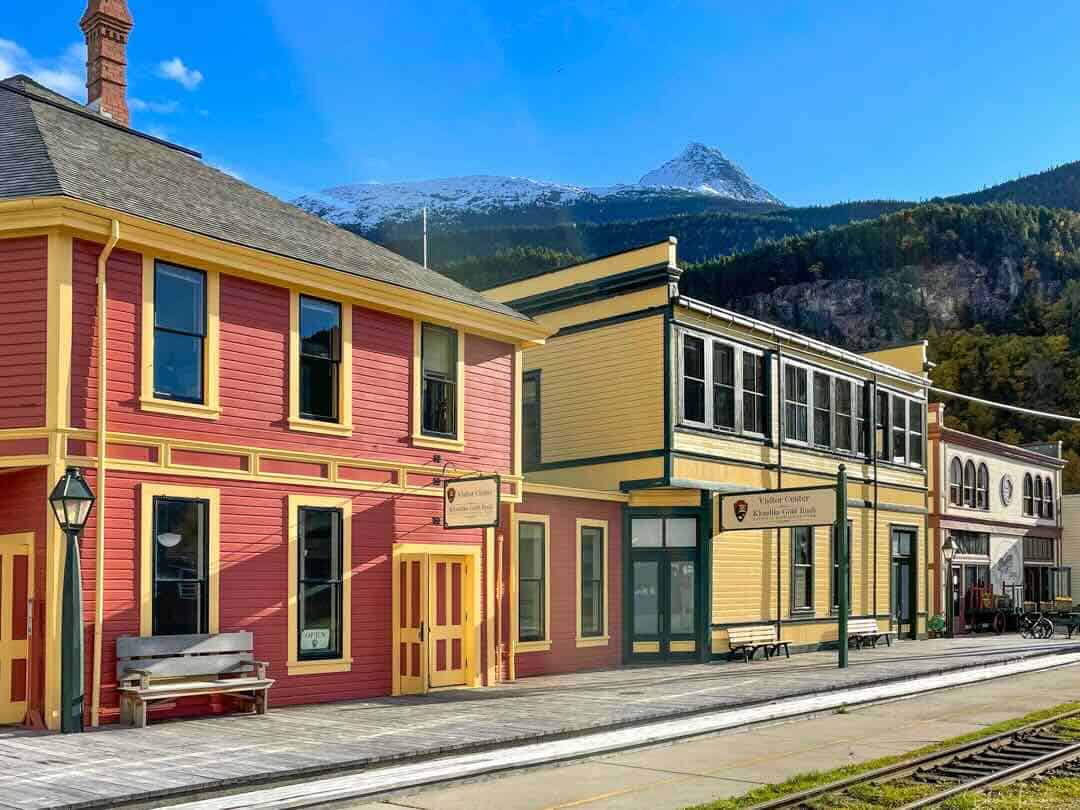
The National Park (website) manages four units within 13,191-acres that encompasses the historical district in Skagway, the nearby ghost town of Dyea, and the famous Chilkoot and White Pass Trails.
True to its mission, the National Park Service restored and preserved many of Skagway’s original buildings so the public could more easily grasp the past.
The J. Bernard Moore House, built by the city’s founder, William Moore, now shines in its 1904 glory. It is furnished with many original family possessions. You get a true sense of life in an Alaska gold rush era.
Built-in 1898, the Mascot Saloon, one of the town’s earliest brothels, functioned as one of 70 saloons open during Skagway’s heyday or “the roughest place in the world.” Today, Mascot is the only saloon in Alaska that doesn’t serve beer, wine, or a drop of whiskey.
Instead, the restored bar serves as a museum that examines the vices of gambling, drinking, and prostitution. Here’s your chance to learn some shady history.
I was intrigued by a building faced with thousands of pieces of driftwood. I heard it is possibly the most photographed building in Alaska. The former Arctic Brotherhood Hall now functions as the Skagway Convention & Visitors Bureau. You can’t miss it! The facade features 8,833 pieces of driftwood that were attached in 1899 and extensively renovated, piece-by-piece, in 2005.
Visit the Gold Rush Cemetery
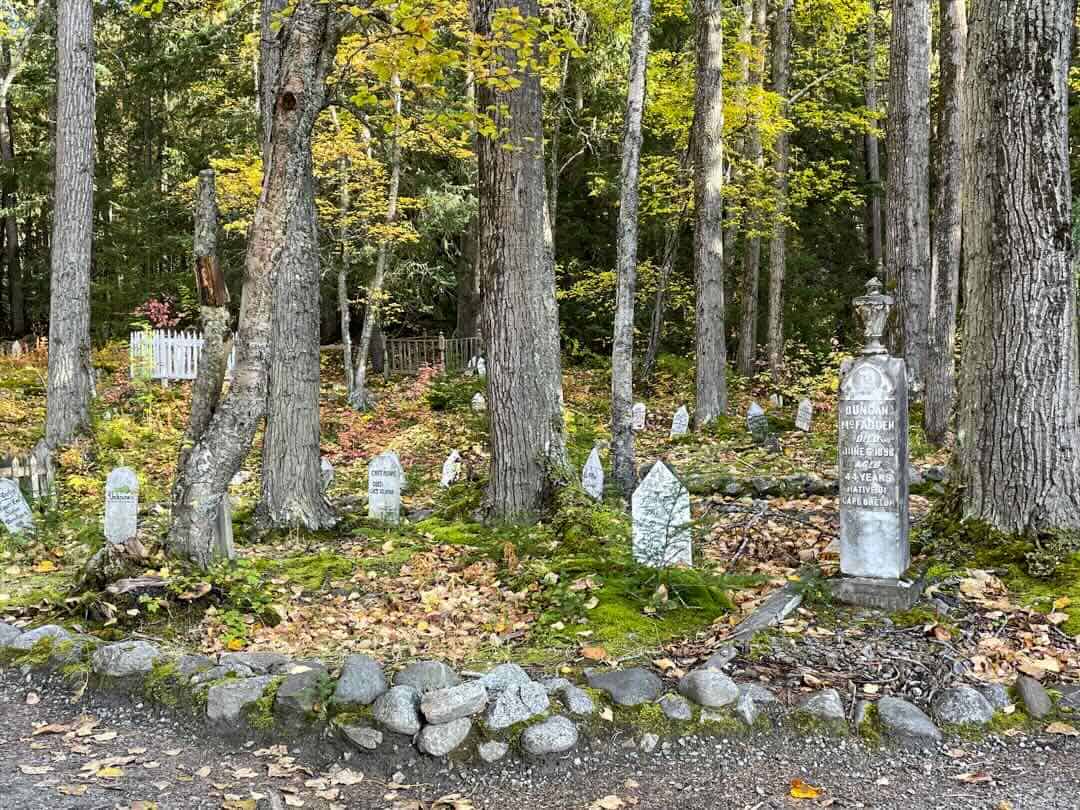
You can’t visit Skagway without hearing about Soapy Smith and his misdeeds. However, his career was short-lived, ending in a shoot-out with Frank Reid, the city engineer, in 1898.
When it was time for my afternoon tour, I boarded a converted yellow ‘streetcar’ on wheels. We rolled down Broadway, traveling to the cemetery.
Our animated and costumed tour guide recalled the town’s history and the story of Soapy and Frank Reid in great detail. She explained how the devilish man took advantage of the naive stampeders. She told how Frank staged a gunfight with Soapy. Soapy died that night, but Frank lingered for twelve days.
The tour group visited their graves and other gold panners. Unfortunately, the tour didn’t allow time for a short hike uphill to Reid Falls, which cascades 300 feet down the mountainside.

We did, however, ride up to the Skagway Scenic Overlook for panoramic views of the town and harbor, including the site of our massive cruise ship.
As we drove around, I noticed beautiful gardens at many homes. The summer days are very long, and plants grow big.
Boomer Travel Tip
MedjetAssist Members who are hospitalized 150 miles from home receive medical transport to a home-country hospital of choice. Memberships from $99.
Experience the Chilkoot Trail
Serious hikers and backpackers often visit the nearby ghost town of Dyea. Today, Dyea still serves as the starting point for hikes on the famous 33-mile Chilkoot Trail, one of Alaska’s most popular backpacking routes. Allow 3-4 days to complete this challenging adventure –and then imagine attempting it in winter.
If you plan to hike Chilkoot, stop at the Trail Center for information and permits. More than 10,000 attempt the trail hike, backpack, and run each year.
Cruisers may hike a portion of the Chilkoot Trail on a half-day guided shore excursion that includes a float trip.
Attend the Days of ’98 Show
The Days of ’98 Show has entertained audiences for over 100 years. The evening melodrama begins with mock gambling and ends with Soapy Smith and his slippery gang.
Northern Lights Photography
Skagway’s remote location offers a grand opportunity for astral or milky way photography and the chance to see the Northern Lights between mid-September and late April, peaking in March.
Getting to Skagway
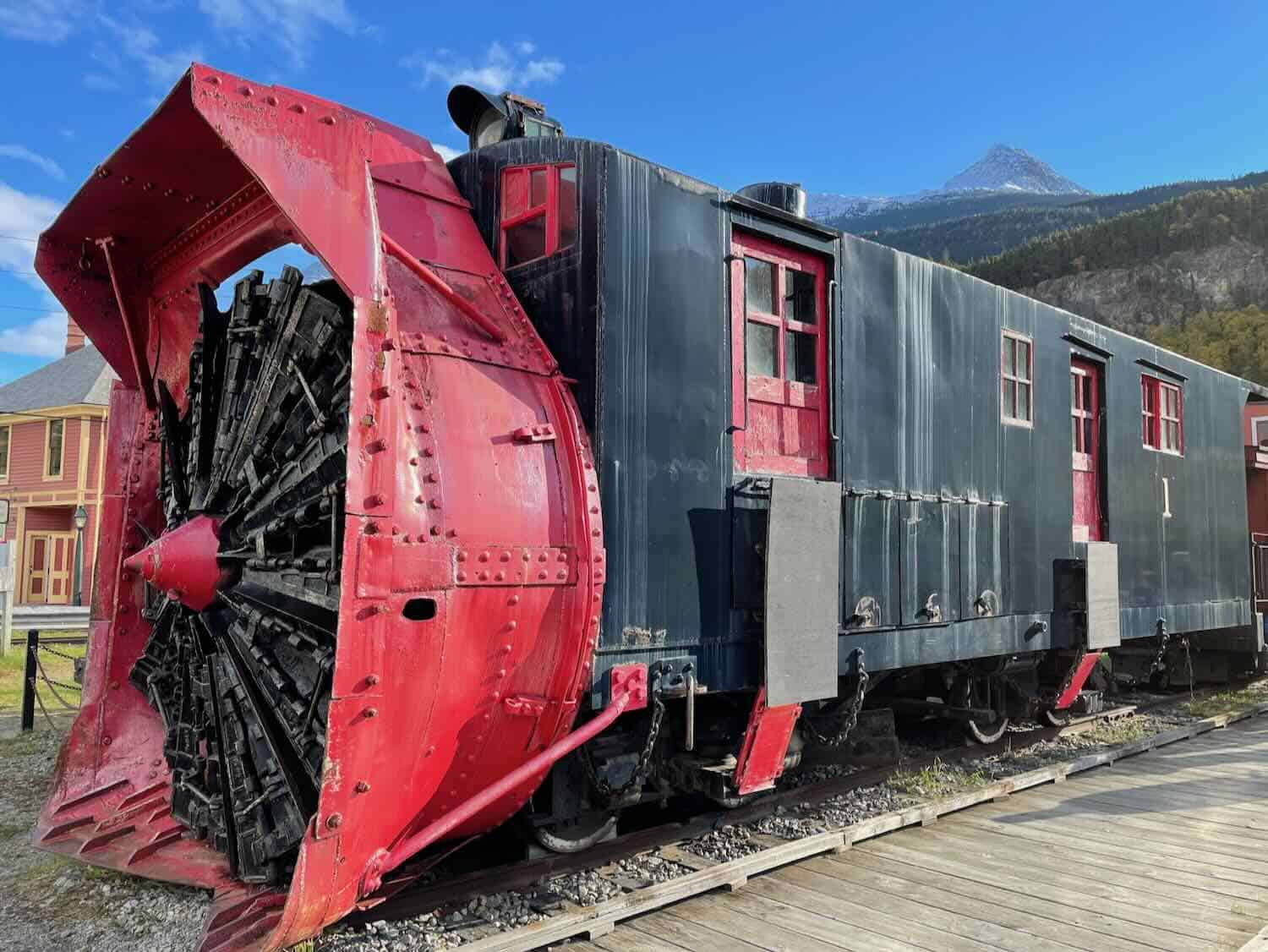
While most visitors to Skagway arrive on cruise ships, Skagway is also accessible via the Alaska Marine Highway ferry system.
Several companies provide air-taxi service between Skagway and other Inside Passage communities, with daily scheduled flights between Juneau and Skagway.
Skagway is also one of the few Inside Passage communities accessible by road using the Klondike Highway, which crosses the U.S./Canadian border into the Yukon Territory. This route is part of the Golden Circle road trip that travels between Skagway and Haines (or vice versa).
What to wear on an Alaska cruise
Do you need help packing for your Alaska cruise? Check out my Alaska cruise packing tips.
Alaska cruise shopping list
Is your Alaska cruise coming up quickly? This Amazon shopping list makes it easy for you to purchase what you need all in one place. Happy shopping!
Kirkland Signature Ladies' Water-Repellent Wind Resistant Softshell Jacket
I wear my red Kirkland Signature jacket on almost every adventure. The lining adds a bit of warmth, plus the outer shell is water repellent and wind resistant. It fits easily over a fleece jacket if you need to layer up for additional warmth.
Columbia Women's Benton Springs Full Zip Jacket, Soft Fleece with Classic Fit
Wear a fleece jacket over a turtleneck or henley shirt and you'll be warm enough for most Alaska cruise adventures. Slip a rain jacket over it to stay dry or for additional warmth. That's what I do!
Columbia Women's Saturday Trail Pant, Water and Stain Resistant
A trail pant that's water and stain resistant? Yes, please. What a perfect addition to your Alaska cruise wear.

Amazon Essentials Women's Mid-Weight Puffer Vest, Navy, Large
Layer a quilted vest over long sleeve turtleneck or short-sleeve shirt for those days when you don't need a coat but a little bit of warmth around your core makes for a comfortable cruise excursion.
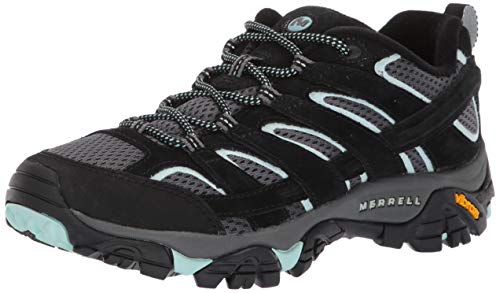
Merrell Lightweight Hiking Shoes
Lightweight hiking shoes double as fitness shoes on my Alaska cruises. Although, with all the fun Alaska activities, who has time to work out in the ship's gym?
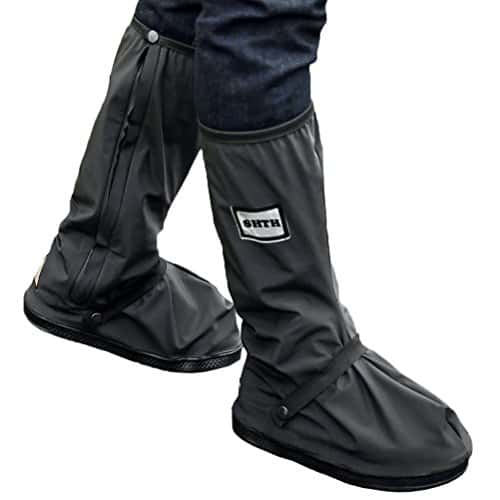
Waterproof Rain Boot Shoe Cover
Packing shoe covers that have treads is a smart move. These are perfect for covering lightweight hiking shoes rather than bringing heavy waterproof boots. And the treads provide sure footing.

EmeTerm Motion Sickness Band
When the seas get rocky, I put on the EmeTerm anti-nausea wristband. It really works! The motion sickness band is rechargeable and comes with conductive gel. Put this tiny tens-type unit to work on your seasickness.

Cliganic Mosquito Repellent Bracelets
Clignaic Mosquito Repellent Bracelets come in a 10 Pack. The DEET-Free bands are Individually wrapped making them convenient for travel. And the bands can be worn more than once.


